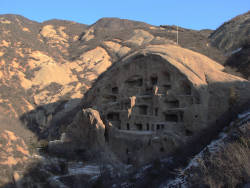古崖居
Guyaju Caves - Yanqing Ancient Cliff House
Useful Information
| Location: |
Dongmenying.
90 min drive from Bejing, northwest of Bejing, Zhangshanying Town, Yanqing County. (40.465018, 115.767801) |
| Open: |
All year daily. [2022] |
| Fee: |
Adults CNY 54. [2022] |
| Classification: |
 Cave House Cave House
|
| Light: | n/a |
| Dimension: | |
| Guided tours: | self guided, D=2 h. |
| Photography: | allowed |
| Accessibility: | no |
| Bibliography: | |
| Address: | Guyaju Caves, County Road 010, Dongmenying Village, Zhang Shanying Town 075411, Tel: +86-10-6911-0333. |
| As far as we know this information was accurate when it was published (see years in brackets), but may have changed since then. Please check rates and details directly with the companies in question if you need more recent info. |
|
History
| 1000 | inhabited by the Kumo Xi people. |
| 1984 | discovered during a cultural relics survey conducted by the Yanqing County Cultural Relics Administration. |
| 1991 | opened to the public. |
| MAY-2013 | listed as a Major Historical and Cultural Site Protected at the National Level. |
Description

The 古崖居 (Guyaju Caves), also known as 延庆古崖居 (Yanqing Ancient Cliff House), are a series of 117 man-made caves cut into the soft rock of a cliff face. Inside each cave are in average three chammbers, in total 350 hambers with a total area of 3,931 m². Actually there are three different layers of rock which were suitable for the creation of caves. The upper level offers great views of the flatland below, but only the lowest level of caves is open for exploration. The site is the largest cliff dwelling site found in China so far [2016].
The caves were inhabited more than 1,000 years ago by the so-called Kumo Xi People, which are also called the Tatabi. At some point about 1,000 years ago the caves were abandoned and the inhabitants vanished. But there are alternative theories, like the complex was built by outlaws on the run, or it was as a military garrison during the Tang Dynasty or during the Han Dynasty. There is even a theory it was a granary built in the Tang Dynasty. There is also the theory that the caves were inhabited only for about 30 years. The whole history of the caves remains enigmatic, there is no sufficient archaeological evidence to explain what happened. No organic materials for reliable dating were found, nor are there any murals or carvings.
The caves are more or less of square shape, but somewhat irregular, looking more like modern art than a city. Probably this was a result of changing hardness of the rock, or simply lack of sufficient tools. Some caves contain ovens or fire places, others troughs which suggests the use as stables. One of the caves is called Chieftain’s Palace, because it is of bigger size having eight rooms and a fancier entry with columns. Obviously this is just a name, and no archaeologist can tell what this cave was really used for. It is located at the bottom of one of the rock faces.
The caves do not contain much archaeological evidence, but they have some distinct features. Kang bed-stoves, flue, window holes, and lampstands were chiseled into the rock. Also the roof is chiseled with a stone slot for collecting rainwater.
 Search DuckDuckGo for "Guyaju Caves"
Search DuckDuckGo for "Guyaju Caves" Google Earth Placemark
Google Earth Placemark Guyaju Caves - Wikipedia
Guyaju Caves - Wikipedia Explore the Mysteries in Guyaju Caves (Ancient Cliff Dwellings) (visited: 08-JUN-2022)
Explore the Mysteries in Guyaju Caves (Ancient Cliff Dwellings) (visited: 08-JUN-2022) Index
Index Topics
Topics Hierarchical
Hierarchical Countries
Countries Maps
Maps